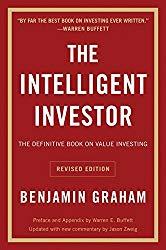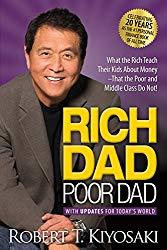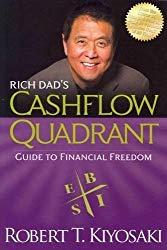If you’re like most people, you probably had no one in your home who invested. Even if you did, because kids and parents talk about finances about as often as they talk about sex, you probably got very little information. Most people have no idea what any of the terms mean or even the mechanics of buying and selling stocks and bonds. When many people realize that they need to start investing because they suddenly have a 401k to manage or they realize that it is the path to financial independence, but have never done it before, their instinct is to find a professional to help them out. After all, they know what they’re doing and you’d be much safer putting things in their hands than to try to take it on yourself, right?
(Note, if you click on a link in this post and buy something from Amazon (even if you buy something different from where the link takes you), The Small Investor will receive a small commission from your purchase. This costs you nothing extra and is the way that we at The Small Investor are repaid for our hard work, bringing you this great content. It is a win-win for both of us since it keeps great advice coming to you (for free) and helps put food on the table for us. If you don’t want to buy something from Amazon or buy a book, how about at least telling your friends and family about our website as a great place to learn about investing and personal finance. Thanks!)
Unfortunately, many money management professionals don’t really have a good background in investing. In some cases, they just get very little information at all. They may have perhaps read a few primers from their company on stocks, bonds, mutual funds, etc… and then taken a few seminars on how to sell annuities and company-proprietary (read high-fee) mutual funds to clients, but they really don’t understand what they’re selling and just repeat what they have heard. In other cases, they may have actually read and studied about investing a lot, but not have much experience actually investing. They might even have a degree in business or finance from a university, but really learning all of the nuances of investing takes both a lot of reading and a lot of experience.
Last week I was listening to an investment advisor in a podcast give a short talk on investing. Most of the information he gave was accurate, but when he got to explaining growth and value funds, he missed some really critical points. I’m not sure if he doesn’t understand these investing styles or he was just trying to make it easier for the audience to understand, but you really need to have a good grasp on these when deciding how you want to invest your money, be it in a 401k or just a standard brokerage account.
This advisor was doing fine talking about things like target-date funds and the effects of inflation, but then he started talking about growth and value funds. He basically said that growth funds invested in companies that are growing, so this is where you want to have your money when you’re trying to grow your 401k. This is fairly accurate and really not that bad for advice. He then, however, went into value investing and said that these were invested in the safer, bigger companies that pay big dividends. Uh, no.
It is true that there are big companies that pay big dividends, but you would not find these necessarily in a value fund. (Want to learn more about dividend investing, which is a great way to generate passive income? Check out Automatic Income: How to Use the Power of Dividend Investing to Beat the Market and Generate Passive Income for Life
Two Investing Styles
While you can make money in stock investing through dividends, and this provides a much more reliable return than other forms of investing, you get higher returns over long periods of time by buying stocks at a low price and selling them at a higher price. This is called a capital gain. There are two fundamental styles of investing when you are investing in stocks and hoping to make money through capital gains, Growth and Value. Growth investing came out what was called momentum investing, where you buy stocks that are going up and reaching new highs because such stocks tend to continue to do this for a while. This is often called the Castle in the clouds method because people are building these lavish structures that reached higher and higher into the stratosphere in their minds, but there is really nothing holding them up. Despite this lack of a foundation, these castles could grow and grow, with people being eager to buy because the stock is increasing in value so rapidly. They see that it had gone up 20% last month and figure that they would get 20% the next month as well.
Value investing came out of what was called the firm-foundation theory. Unlike momentum investing, firm-foundation investors look for stocks that are well-priced based on fundamentals like company assets and earnings. They actually calculate a fair value for a stock, then find stocks that are inexpensive relative to the value they calculate. Think about it like going to the store and buying things when they are on sale, then selling them later when the price goes up.
Warren Buffett is a firm – foundation guy as was his mentor, Benjamin Graham. (Note that you really should check out Benjamin Graham’s classic book on value investing, The Intelligent Investor: The Definitive Book on Value Investing.

So if Value investing safe?
Listening to the advisor, you might equate growth with risk but big profits and value with safety but smaller profits. You’d be wrong. While it is true that value stocks might hold up better when the market falls than growth stocks because they are already cheap, during an economic downturn, value stocks are more likely to go bankrupt and disappear than growth stocks. Why is this?
Think about plants or animals. Growing things are fundamentally healthy. They can take a bout of disease or harsh conditions because they have reserves to fall back on. Things that have fallen back have already used up these reserves. A person who has been sick and has a compromised immune system is at a far bigger risk from the flu than a healthy adult. If things that are sickly are hit by something else, they may not have enough to bounce back. A company that has had issues and needed to sell off things to cut costs and make a turn-around may not be able to withstand a big downturn in the economy since they don’t have much else to sell to keep going through the downturn.
Value stocks also probably don’t pay big dividends. The reason is that they’re doing all they can to turn around the business. They don’t have a lot of cash to dole out to shareholders. Sometimes they might have a high yield initially, right after they decline in price, but the company will cut the dividend shortly afterward. Large dividends should always be viewed as suspect when choosing stocks.
You should own some value stocks
While they can be riskier than growth stocks, you should still own some value stocks. Why? Because over long periods of time, particularly when there have been some periods that include market bubbles like 1999, value stocks have beat growth stocks for returns. The stocks that get astronomical values in a market bubble are always growth stocks, especially those that are a fad. Value stocks are largely ignored during these periods since people want what’s hot, not what’s cold. For this reason, you’ll want to include value stocks in your portfolio so that when bubbles happen you aren’t hurt as much as you would be if you’re entirely in growth stocks. In fact, you might actually see a gain as people flee growth stocks for value stocks as a bubble is bursting. You just don’t want to overweight in value stocks thinking that you’re reducing your risk. You’re not.
In the stock portion of your portfolio, you’ll want to have about an equal portion of growth and value stocks. In fact, because value stocks tend to outperform growth stocks over long periods of time, you may want to skew slightly towards value when you have 20 years or more until you need the money. For example, when you’re in your twenties through about your mid-forties you might invest 55% or your 401k funds in value funds and 45% in growth funds. Alternatively, you might just invest 80% in balanced funds, which would invest in both growth and value stocks, but then add a value fund for the other 20% to tilt the scale just a little. For example, using the Vanguard funds as a group to pick from, I might have in a 401k:
Vanguard S&P 500 Index Fund: 30%
Vanguard Total International Stock Fund: 20%
Vanguard Mid-Cap Fund: 15%
Vanguard Small-Cap Index Fund: 15%
Vanguard Windsor Fund: 20%
The first four funds are all balanced funds. I’ve included both US and international stocks. I’ve also included both large and small stocks in about equal proportions. Finally, I’ve added 20% in the Windsor fund, which is a large-cap value fund. This skews me just a little towards value. Notice that I don’t bother to have any bonds or income funds. At this time of my life when I have decades before I’ll need the money in retirement, I want to grow my account value, not generate income. I also want to have the inflation protection I’ll get from stocks but not so much from bonds.


Rich Dad Poor Dad: What the Rich Teach Their Kids About Money That the Poor and Middle Class Do Not!
What to expect from your value stocks
Often you’ll be disappointed with your value stocks. When the markets are flying up and everyone is a genius in the stock market, your value stocks will lag behind. Maybe your friends will have a 30% return with their growth stock portfolios and you’ll only have a 15% return. The stocks in a value fund are companies that need to go through a turn-around, so they won’t be the ones that everyone is buying. In fact, companies become value companies when people aren’t paying attention to them and therefore aren’t giving them the share price they deserve. During periods of big market moves upwards growth stocks will outperform value stocks.
When the markets are down or just languishing, however, value stocks will outperform growth stocks. Perhaps they’ll only go down 15% during a big bear market where growth stocks go down 40%. Perhaps when stocks are just treading water, moving up and down each week but not going anywhere, some of your value stocks will turn themselves around and advance upwards. Over long periods of time, you’ll be glad you have a value portion in your portfolio.
Want to learn a lot more about stock investing?
If you want to go from being one of the crowd to a sophisticated investor, pick up a copy of

Have a burning investing question you’d like answered? Please send to [email protected] or leave in a comment.
Follow on Twitter to get news about new articles. @SmallIvy_SI
Disclaimer: This blog is not meant to give financial planning or tax advice. It gives general information on investment strategy, picking stocks, and generally managing money to build wealth. It is not a solicitation to buy or sell stocks or any security. Financial planning advice should be sought from a certified financial planner, which the author is not. Tax advice should be sought from a CPA. All investments involve risk and the reader as urged to consider risks carefully and seek the advice of experts if needed before investing.
